
|
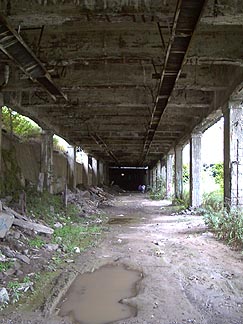
The Beautiful Abandoned Subway of Rochester, New York
by Liz
With the aid of a handful of internet printouts and repeated warnings that "I hear a lot of people live down there...", Ninj and I set off in search of the ruins of the Rochester, NY subway system.
Rochester is the smallest city to have built (for reasons that remain somewhat unclear to me) and subsequently abandoned a subway system. Open from 1927-1957, the Rochester Industrial and Rapid Transit Railway operated track for both commuter subway trains and an interurban transit junction underneath downtown Rochester. Ultimately, the subway's inability to serve the outlying suburbs (due to the city's inability to justify the expenditure) led to its failure. The subway was closed, and what remained of the tunnel system was either filled in due to crumbling infrastructure, or left abandoned. (With one exception — the track area underneath the Gannet newspaper plant near City Hall was still used for paper deliveries up until as recently as 1996.)
Ninj and I elected to enter the portion of the system accessible from South Street, right downtown. After walking around the city extensively the night before, it seemed hard to believe there would be a whole subway system right underneath our feet that no one who didn't care to know such things would ever know about. But, there it was — behind a fence right behind the Rundell Memorial Library and right before the freeway interchange, a clearly visible portion of the Court Street station revealed itself down a hillside, its siren call unmistakable.
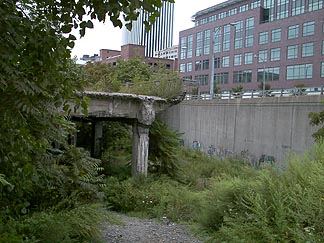
The entrance to the Rochester tunnels is wide open
beside a main street in downtown Rochester.
We followed the fence along the hillside a short way until it ended in an explosion of weeds. At the top of this small hill were three well-worn paths down, and a few highway detour signs cast off into the brush by city workers. Before we had even made it halfway down the path, we had company. A scrappy looking 30-ish guy came up from behind us. He was carrying what appeared to be a "to-go" container from a restaurant, and greeted us with a pleasant "Hey! You guys ever been down here before?" to which Ninj rather un-suavely answered "Uh, no, we're from out of town." Takeout-man quickly disappeared somewhere to eat his lunch. Not far behind him were a couple of younger guys wearing really large headphones. They greeted us as well and then disappeared ahead of us to go smoke or drink beer or something.
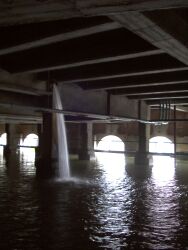 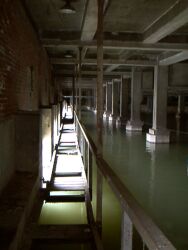
The underground pools and waterfall are surprising and wonderful. One can walk across the water on a fragile catwalk and stare down at the Gennessee River outside.
At the bottom of the hill, a portion of road or bridge is broken off above the entry to a dilapidated "room". Was that the sound of water up ahead? Oh yes. Coming inside, Ninj and I were completely stunned to find the remains of Court Street station — the majority of which was a large chamber filled with water, broken pipes in the ceiling above creating incredibly gorgeous urban waterfalls. Two stone archways formed the back wall (in the same direction we'd come from) of the water-chamber, which was elevated about three feet from the ground and accessed by a short ladder and various walkways. On the south side of the chamber, low cement arches allowed the water to drop freely to a path returning it to the Genessee River, cascading across flat smooth rocks down a low waterfall. On the north side of this room were the remains of the staircase into the station, barely existing but still gorgeous for the arched structure underneath. The evidence of someone's bed lay up the stairs, so we didn't explore here. Going further inside, a strange little house/building appeared over to the right, its former purpose unclear.

The thoroughly graffitied bridge is a patch of
light between dark tunnels.
The path then curved to the left and within a few short steps we found ourselves along the scenic, heavily graffitied subway tunnel under the Broad Street Bridge. We took the south half of the tunnel along its length — the whole portion of the journey had been exceedingly well-lit so far (in fact, part of Court Street station is still being lit by a few sodium lamps), and the bridge itself was the brightest, a cement tunnel with open archways all the way across the Genesse. Up ahead, though, was about the darkest thing I had ever seen. Twin pitch-black holes greeted us at the end of the span. Our pocket flashlights cowered in their spectre. We turned them on and entered the first fully underground tunnel.
Dark, dark, and dark, this tunnel creeped me out. The further we got from the Broad Street bridge, the more I kept sticking my flashlight into corners to make sure no person or thing I didn't want to encounter was there. The ground was dirty and gravelly, and we found the remains of a track bed and began to walk along that. Large chunks of rock regularly appeared at our feet, so the going was careful. Portions of rail still remained. Pillars flanked us on both sides, but the tunnel was really very wide. Thinking back on what I know now, I think many portions of the tunnel had room for at least three tracks, two for passenger subways and one for freight traffic. No evidence of former platforms was at any time visible.
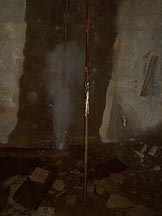 A bizarre ratchetty noise ("like the metal sound of a rollercoaster going uphill" according to Ninj, who likes rollercoasters more than I do) was off in the distance. We stopped and listened for awhile — it was too regular to be human, but it was still creepy in all that darkness. Near the end of this segment of tunnel we found the culprit: an exceptionally loud, yet small, steam valve, shooting geysers of steam high into the air at regular intervals. Near the geyser, blocking the front of the track, was a portion of wall, with an open doorway. We went through the doorway to be greeted by a blast of hot, moist air... and more tunnel.
A bizarre ratchetty noise ("like the metal sound of a rollercoaster going uphill" according to Ninj, who likes rollercoasters more than I do) was off in the distance. We stopped and listened for awhile — it was too regular to be human, but it was still creepy in all that darkness. Near the end of this segment of tunnel we found the culprit: an exceptionally loud, yet small, steam valve, shooting geysers of steam high into the air at regular intervals. Near the geyser, blocking the front of the track, was a portion of wall, with an open doorway. We went through the doorway to be greeted by a blast of hot, moist air... and more tunnel.
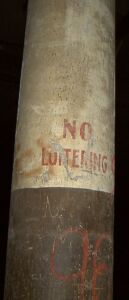 This second dark tunnel was even darker than the first, if that's even possible. With flashlights off it would be pitch black in all directions, and I seem to remember repeating "this is really scary" a few times as we kept going further and further into this superdark, remarkably sauna-like hole. The track bed here had become paved in the centre, and this was easy to walk along while looking around trying to figure out where we were changing from tunnel to station, if at all. On the south side were tracks punctuated by those large triangular wooden things they use, well, at the end of railroad track. I gather that this segment of track was for freight, as they ran alongside what we would soon discover were the old loading docks of the Gannet newspaper plant. This accounted for the stray bits of safety signage (that was definitely NOT circa 1957) we'd seen just nearby. The docks had a few dirty gloves and fuses lying around, but nothing of interest. (Really, there were no artifacts anywhere in the tunnels at all, save for the usual beer cans, destroyed cassette tapes, and what I am pretty sure was once a saucy red-and-silver lingerie ensemble.) At some point here the pillars changed from square to round, and we could read the stencilled words "NO LOITERING" on some of the poles. This was City Hall Station, or what was left of it, anyway.
This second dark tunnel was even darker than the first, if that's even possible. With flashlights off it would be pitch black in all directions, and I seem to remember repeating "this is really scary" a few times as we kept going further and further into this superdark, remarkably sauna-like hole. The track bed here had become paved in the centre, and this was easy to walk along while looking around trying to figure out where we were changing from tunnel to station, if at all. On the south side were tracks punctuated by those large triangular wooden things they use, well, at the end of railroad track. I gather that this segment of track was for freight, as they ran alongside what we would soon discover were the old loading docks of the Gannet newspaper plant. This accounted for the stray bits of safety signage (that was definitely NOT circa 1957) we'd seen just nearby. The docks had a few dirty gloves and fuses lying around, but nothing of interest. (Really, there were no artifacts anywhere in the tunnels at all, save for the usual beer cans, destroyed cassette tapes, and what I am pretty sure was once a saucy red-and-silver lingerie ensemble.) At some point here the pillars changed from square to round, and we could read the stencilled words "NO LOITERING" on some of the poles. This was City Hall Station, or what was left of it, anyway.
Now, while I mentioned already that this was the darkest and most uncomfortable of the tunnels, it was also the scariest, due to a terrifying and LOUD noise that we had been hearing grow louder all the way back from the entrance. This noise sounded like nothing less fearsome than a zombie-monster dragging its enormous coffin behind it, trailing metal chains along the ground. It was god-awful sounding, really. The only human thing I could even conceive of it being in real life was a batallion of angry homeless residents hauling heavy trash cans behind them in order to attack us, but that seemed rather unlikely, and, like the noise before, the pattern was far too regular for it to be human. That didn't keep me from being deeply spooked every time the sound cycled (which was every ten seconds or so). At times it seemed to be coming from ahead of us, at times it seemed to be right above us. But we kept going forward, eventually coming upon the root of the cacophany: yep, another humble steam valve. This would be an excellent site for field recordings...
At the end of this tunnel was another phantom dead-end. That is, approaching the ends of these tunnels we kept half-expecting them to be walled-off, as I'd understood some of the segments of the subway were. But as we got closer, there was yet another passageway into the next room — and this one had light leaking in from above! And sand on the ground instead of rubble or pavement. And in the sand... tire tracks. I remembered reading on the net about a guy who had driven a jeep into one of the tunnels, and I wondered if this tunnel didn't go above-ground again soon. We approached a portion of tunnel where the room changed character again and decided this must be West Main station. More and more light came from the southeast, and we were very curious to find out where it ended up when we saw our first rat. Our little friend was black and chubby. More than the humans or danger or scary noises, this rat scared us both. We stood in place and discussed the rat for a little while, then cautiously kept going. A few minutes later we saw a second, much larger rat, and with little ado, decided they'd be much happier alone in their rat-world and turned back along the long path.
We suspect the tunnels do indeed emerge again not too far past where we gave up. This map from 1928 seems to indicate that the track heads above-ground again near Exchange Street, which would probably account for the tire tracks, and the proliferation of rats due to the proximity to humans and trash, and explain why it got so much pleasantly cooler the further away from Sauna Tunnel we went.
Anyway, we made our way back out (Ninj pointed out that these tunnels would be extra-unpleasant for a claustrophobe — it's a long way out once you're way in, and there are no possible emergency exits) not too dirty and completely unscathed. The residents or visitors we'd seen at the entry earlier were nowhere to be seen, so we enjoyed the water room for a little while longer and headed out into the overcast, but suddenly very bright, Rochester afternoon. 
|
|

